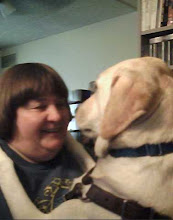When Woody and I came home to my apartment in York, there was the usual period of adjustment, with the dog getting to know our environment, and the lay of the land, so to speak. But there were a great many other adjustments that had to take place on the part of the townfolk, too --- getting accustomed to the dog's presence, and learning about how he was trained to help me.
I had been in touch with Housing Authority Executive Director Robert J. Sylvester, and our Board ever since I started researching getting a Service Dog. I wanted everything to be on the up-and-up from the beginning. Since there were no other assistance dogs in town, I was destined to be a pioneer. I showed Sylvester and the Board the 15-minute film from KSDS about its training facility, and what the dogs were like. I'm sure that when I first approached the Board about getting a canine assistant, some of the members envisioned me with a huge unruly dog that would cause a lot of problems. They were impressed and reassured with the quality of training and level of professionalism shown on the KSDS film. So the Board felt a lot better about welcoming a Service dog to live here. In trying to make a smooth transition from wheelchair-me-by-myself to wheelchair-me-plus-dog, I wanted to get the word out to my neighbors. They were going to be around us on a daily basis, and I felt they needed to know what was going on with the dog. I asked Sylvester if he would consider writing a memo from his office to the tenants, and let them be aware of the working dog that was going to be with me, and to touch on a few basics of Service Dog protocol. He was happy to do so, and sent out this memo to my neighbors:
HOUSING AUTHORITY OF THE CITY OF YORK
YORK, NEBRASKA 68467
YORK, NEBRASKA 68467
October 4, 1995
RE: Assistance Dog
We would like to notify you that Sue Curran has qualified to receive an assistance dog from the Kansas Specialty Dog Services. Some of the items this assistance dog will be able to do for her are as follows:RE: Assistance Dog
Pull a wheel chair
Open doors
Retrieve dropped items
Turn on light switches
Open doors
Retrieve dropped items
Turn on light switches
As you will be in the same area of the assistance dog at times, you must remember this dog is a working animal. When you see the dog with its harness on, please do not do anything that would distract the dog from its job.
Sue has been in Kansas for training and will be arriving with her dog on October 7, 1995.
Executive Director
RJS/cs
©1995 RJS
That proved to be an invaluable tool to get off on the right foot, to let people know that my canine assistant was not a glorified pet, but a bonafide, certified Service Dog.
An equally important tool in those efforts was a letter sent out to my town's merchants. Since I'm a member of a local disability rights group, the League of Human Dignity, I enlisted the help of our president, and the local Chamber of Commerce. The Chamber agreed to send out a letter to the local merchants regarding my Service Dog, briefly outlining the dog's duties, as well as talking about legal rights of a disabled person accompanied by an assistance dog. That letter read:
MEMO TO: THE YORK MERCHANTS
FROM: THE YORK CHAPTER OF
THE LEAGUE OF HUMAN DIGNITY
FROM: THE YORK CHAPTER OF
THE LEAGUE OF HUMAN DIGNITY
This is to inform you that one of our members, Sue Curran, has applied for a Service Dog. Sue is currently taking the specialized training at Kansas Specialty Dog Service to learn to work with the animal. She will be coming back to York with the dog on Oct. 7th. It will assist Sue by pulling her wheelchair, retrieving dropped or hard-to-reach items, doing stand-and-brace when Sue transfers to/from her wheelchair, and helping open heavy doors.
According to Title III of the Americans with Disabilities Act, a blind, deaf, or physically disabled person has the legal right to be accompanied by a service animal in all areas open to the general public. Service animal means any guide dog, signal dog, or other animal individually trained to do work or perform tasks for the benefit of an individual with a disability, including but not limited to guiding individuals with impaired vision, alerting individuals with impaired hearing to intruders or sounds, providing minimal protection or rescue work, pulling a wheelchair, or fetching dropped items. A public accommodation shall modify policies, practices or procedures to permit the use of a service animal by an individual with a disability in any area open to the general public.
[Remember, this was 1995. There were laws in Nebraska governing the rights of Guide Dogs and Hearing Dogs, but the laws had not yet been amended to include Service Dogs. However, I was still covered under the Americans with Disabilities Act. The Nebraska legislature had voted to enact the ADA, so the dog and I were protected by Federal law.]
Anyway, like I said, each of those letters were key pieces of info that helped my neighbors and local merchants get used to having a Service Dog around. Woody and I were like Captain Kirk, in a way... boldly going where no Service team had gone before!
©2009

